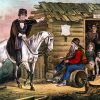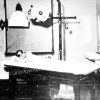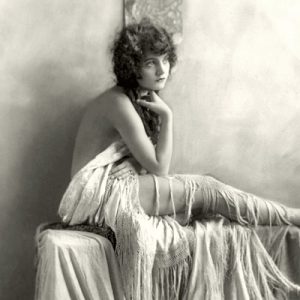calsfoundation@cals.org
Winona Sammon (1907–1941)
aka: Peggy Shannon
Winona Sammon was a stage and cinema actress in the 1920s through early 1940, using the stage name Peggy Shannon. There were high hopes for her career early on, but as it progressed, her roles became smaller and less prestigious.
Winona Sammon was born on January 10, 1907, to Edward and Nannie Sammon in the upstairs living quarters over her father’s store on Barraque Street in downtown Pine Bluff (Jefferson County). She had a younger sister.
In late 1923, she traveled to New York City with her mother to visit an aunt, who lived in the same building as Florenz Ziegfeld’s secretary, “Goldie” Glough. Sammon was invited for some publicity pictures with Ziegfeld, who, with famed choreographer Ned Wrayburn, chose her for the latest edition of the Ziegfeld Follies. She adopted the stage name Peggy Shannon and rehearsed with the other chorus girls for six weeks, that being her only preparation for a stage career. She remained on Broadway through 1931, appearing in Piggy, What Ann Brought Home, High Gear, Back Here, Now-a-Days, Cross Roads, Damn Your Honor, Life is Like That, and Napi.
During this time, she met her first husband, fellow actor Alan Davis. The two married in 1926. The marriage ended in divorce; they had no children.
In 1931, while on Broadway, Shannon was spotted by Benjamin Percival (B. P.) Schulberg, production head of Paramount Pictures, and offered a contract. With her red hair, she was proclaimed another “It girl.” When Clara Bow suffered a second nervous breakdown, Shannon was hurried in to complete the production of The Secret Call, only two days after her arrival in Hollywood. The film’s world premiere was held in Pine Bluff, where the mayor declared July 14 “Peggy Shannon Day.” Paramount kept her busy and gave her a big publicity build-up, and she became known as one of the most fashionably dressed in Hollywood.
In 1932, she moved to Fox Studios, where she was not compared to Clara Bow, which pleased her. Of being compared to Bow she said, “They brought me to Hollywood to take Clara Bow’s place. Imagine that! I am as much like Clara Bow as onion soup is like a fine day.” During this time, she became known as difficult and temperamental and was rumored to be drinking heavily. At Fox, she made The Painted Woman and Society Girl.
Missing the stage, Shannon headed back to Broadway in late 1934 to appear in a new play, Page Miss Glory, playing the girlfriend of the then-unknown James Stewart. Next, she starred in The Light Behind the Shadow but was replaced when the tour reached Newark. The press release told of a tooth infection, but rumors abounded regarding her excessive drinking. She next starred in Alice Takat before returning to Hollywood in 1936, keeping busy in B pictures with various studios through early 1940 such as Fixer Dugan, Blackwell’s Island, The House Across the Bay, and Café Hostess. She was a favorite of columnist Charles G. Sampas, who kept her name in the papers and continued to do so even after her death.
In 1940, Shannon married cameraman/actor Albert G. Roberts. The marriage lasted until her death and produced no children. There were few offers for work, and she found solace in alcohol.
On May 11, 1941, her husband and a friend of his returned from a fishing trip to find her dead at the kitchen table of their shabby North Hollywood apartment. She was slumped across the table, her head on her arms, a cigarette in her mouth, and an empty glass beside her; she had been dead for approximately twelve hours. The coroner ruled her death was due to a heart attack brought on by a liver ailment and a run-down condition. She was interred in Hollywood Forever Cemetery, just outside of the Abbey of the Psalms; her tombstone was inscribed “That Red Headed Girl, Peggy Shannon, 1910 [sic] – 1941.” Three weeks after her death, her husband shot himself while sitting in the same chair in which Shannon had died. His suicide note read: “I am very much in love with my wife, Peggy Shannon. In this spot she passed away, so in reverence to her, you will find me in the same spot.” His family buried him at Forest Lawn Cemetery in Glendale.
In 2002, Michael Wojczuk painted a mural on the side of a building in downtown Pine Bluff to express the history and culture of the area. The mural, titled “Two Who Shaped the Movies,” honors film pioneers Broncho Billy Anderson and Freeman Owens. Also gracing the mural is Peggy Shannon.
For additional information:
Norwood, Randy. “The Not-Quite-It Girl.” Arkansas Times (December 1990): 25–26.
“Peggy Shannon.” Glamour Girls of the Silver Screen. http://www.glamourgirlsofthesilverscreen.com/show/246/Peggy+Shannon/index.
html (accessed January 26, 2023).
“Peggy Shannon.” Internet Broadway Database. http://www.ibdb.com/person.asp?ID=59693 (accessed January 26, 2023).
“Peggy Shannon.” Internet Movie Database. http://www.imdb.com/name/nm0788347/ (accessed January 26, 2023).
Cheryl Messina
Glamour Girls of the Silver Screen
 Arts, Culture, and Entertainment
Arts, Culture, and Entertainment Early Twentieth Century, 1901 through 1940
Early Twentieth Century, 1901 through 1940 Movies
Movies Theater
Theater Peggy Shannon
Peggy Shannon  Peggy Shannon
Peggy Shannon 




Comments
No comments on this entry yet.